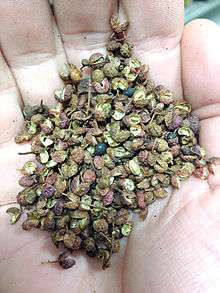Sichuan pepper
Sichuan pepper (Chinese: 花椒; pinyin: huājiāo)[1] is a spice from the Sichuan cuisine of China's southwestern Sichuan Province. It has a unique aroma and flavor that is neither hot like chili peppers nor pungent like black pepper. Instead, it has slight lemony overtones and creates a tingly numbness in the mouth due to hydroxy-α-sanshool. It is commonly used in Sichuanese dishes such as mapo doufu and Chongqing hot pot, and is often added together with chili peppers to create a flavor known in Mandarin as málà (麻辣; "numb-spiciness").

| Sichuan pepper | |||||||||||||||||||||||
|---|---|---|---|---|---|---|---|---|---|---|---|---|---|---|---|---|---|---|---|---|---|---|---|
| Chinese name | |||||||||||||||||||||||
| Chinese | 花椒 | ||||||||||||||||||||||
| Literal meaning | "flower pepper" | ||||||||||||||||||||||
| |||||||||||||||||||||||
| Japanese name | |||||||||||||||||||||||
| Kanji | 山椒 | ||||||||||||||||||||||
| |||||||||||||||||||||||
Despite its name, Sichuan pepper is not closely related to either black pepper or the chili pepper. It comes from the seeds of at least two species of small trees in the global genus Zanthoxylum (colloquially known as "prickly ash") in the family Rutaceae, which includes citrus and rue. The husk or hull (pericarp) around the seeds may be used whole, especially in Sichuan cuisine, and the finely ground powder is one of the ingredients for five-spice powder. Related species are used in the cuisines of Tibet, Bhutan, Nepal, Thailand, the Konkani and Kumaoni people of India, and the Toba Batak of Indonesia.
Names

The Sichuan pepper is known in Chinese as huā jiāo. A lesser-used name is shān jiāo (山椒), not to be confused with Tasmanian mountain pepper, which is also the root of the Japanese sanshō (山椒). Confusingly, the Korean sancho (산초, 山椒) refers to a different if related species (Z. schinifolium), while Z. piperitum is known as chopi (초피).[3]
The name hua jiao in a strict sense refers to the northern China peppercorn, Z. bungeanum, according to the common consensus in current scholarly literature.[4][5][6] However, hua jiao is also the generic term in commerce for all such viable spices harvested from the genus. This includes Z. simulans (Hance), identified by a taxonomical authorities as the yě huā jiāo (野花椒, "wild peppercorn"),[4][7] though elsewhere given as chuān jiāo (川椒, "Sichuan pepper"[8]), leading to the tendency to regard this as the bona fide "Sichuan pepper". While the exact flavor and composition of different species from the genus Zanthoxylum vary, most share the same essential characteristics. So while the terms "Sichuan pepper" and sanshō may refer specifically to Z. simulans and Z. piperitum, respectively, the two are commonly used interchangeably.[9]
The Indian subcontinent uses a number of varieties of Sichuan pepper. In Konkani, it is known as tephal or tirphal.[10] In Nepali, Z. alatum is known as timur (टिमुर) or timbur, while in Tibetan, it is known as yer ma (གཡེར་མ)[3] and in Bhutan as thingye. It is also called current mirchi commonly.
In Indonesia's North Sumatra province, around Lake Toba, Z. acanthopodium is known as andaliman in the Batak Toba language[3] and tuba in the Batak Karo language.
In America, names such as "Szechwan pepper", "Chinese pepper", "Japanese pepper", "aniseed pepper", "spice pepper", "Chinese prickly-ash", "fagara," "sansho", "Nepal pepper", "Indonesian lemon pepper", and others are used, sometimes referring to specific species within this group, since this plant is not well known enough in the West to have an established name. Some brands also use the English description "dehydrated prickly ash", since the Sichuan pepper and Japanese sansho are from related plants that are sometimes called prickly ash because of their thorns (though purveyors in the US do sell the native prickly ash species Z. americanum because it is recognized as a folk remedy[11]).
In Kachin State of Myanmar, the Jinghpaw people widely use it in traditional cuisine. It is known as ma chyang among them. Its leaves are served as one of ingredients in cooking soups. In the Khyber Pakhtunkhwa province of Pakistan, it is known as dambaray or dambara and is mostly used in street foods.
Culinary uses
Sichuan pepper's unique aroma and flavour is not hot or pungent like black, white, or chili peppers. Instead, it has slight lemony overtones and creates a tingly numbness in the mouth (caused by its 3% of hydroxy alpha sanshool). According to Harold McGee in On Food and Cooking, they are not simply pungent; "they produce a strange, tingling, buzzing, numbing sensation that is something like the effect of carbonated drinks or of a mild electric current (touching the terminals of a nine-volt battery to the tongue). Sanshools appear to act on several different kinds of nerve endings at once, induce sensitivity to touch and cold in nerves that are ordinarily nonsensitive, and so perhaps cause a kind of general neurological confusion."[12]
Recipes often suggest lightly toasting the tiny seed pods, then crushing them before adding them to food. Only the husks are used; the shiny black seeds are discarded or ignored as they have a very gritty, sand-like texture. The spice is generally added at the last moment. Star anise and ginger are often used with it in spicy Sichuan cuisine. It has an alkaline pH and a numbing effect on the lips when eaten in larger doses. Ma la sauce (Chinese: 麻辣; pinyin: málà; literally "numbing and spicy"), common in Sichuan cooking, is a combination of Sichuan pepper and chili pepper, and it is a key ingredient in má là hot pot, the Sichuan version of the traditional Chinese dish. It is also a common flavouring in Sichuan baked goods such as sweetened cakes and biscuits. Beijing microbrewery Great Leap Brewing uses Sichuan peppercorns, offset by honey, as a flavouring adjunct in its Honey Ma Blonde.[13]
Sichuan pepper is also available as an oil (Chinese: 花椒油, marketed as either "Sichuan pepper oil", "Bunge prickly ash oil", or "huajiao oil"). In this form, it is best used in stir-fry noodle dishes without hot spices. The recipe may include ginger oil and brown sugar cooked with a base of noodles and vegetables, then adding rice vinegar and Sichuan pepper oil after cooking.
Hua jiao yan (simplified Chinese: 花椒盐; traditional Chinese: 花椒鹽; pinyin: huājiāoyán) is a mixture of salt and Sichuan pepper, toasted and browned in a wok, and served as a condiment to accompany chicken, duck, and pork dishes. The peppercorns can also be lightly fried to make a spicy oil with various uses.
In Indonesian Batak cuisine, andaliman (a relative of Sichuan pepper, Z. acanthopodium) is ground and mixed with chilies and seasonings into a green sambal tinombur or chili paste, to accompany grilled pork, carp, and other regional specialties. Arsik, a Batak dish from the Tapanuli region, uses andaliman as spice.
Sichuan pepper is one of the few spices important for Nepali, Northeast Indian, Tibetan, and Bhutanese cookery of the Himalayas because few spices can be grown there. One Himalayan specialty is the momo, a dumpling stuffed with vegetables, cottage cheese, or minced yak meat, water buffalo meat, or pork and flavoured with Sichuan pepper, garlic, ginger, and onion, served with tomato and Sichuan pepper-based gravy. Nepalese-style noodles are steamed and served dry, together with a fiery Sichuan pepper sauce.
In Korean cuisine, two species are used: Z. piperitum and Z. schinifolium. The pepper is ground and commonly accompanies fish soups such as chueo-tang or maeun-tang. [3]
Phytochemistry
Important aromatic compounds of various Zanthoxylum species include:
- Zanthoxylum fagara (Central & Southern Africa, South America) — alkaloids, coumarins (Phytochemistry, 27, 3933, 1988)
- Zanthoxylum simulans (Taiwan) — Mostly beta-myrcene, limonene, 1,8-cineole, Z-beta-ocimene (J. Agri. & Food Chem., 44, 1096, 1996)
- Zanthoxylum armatum (Nepal) — linalool (50%), limonene, methyl cinnamate, cineole
- Zanthoxylum rhetsa (India) — Sabinene, limonene, pinenes, para-cymene, terpinenes, 4-terpineol, alpha-terpineol. (Zeitschrift f. Lebensmitteluntersuchung und -forschung A, 206, 228, 1998)
- Zanthoxylum piperitum (Japan [leaves]) — citronellal, citronellol, Z-3-hexenal (Bioscience, Biotechnology, and Biochemistry, 61, 491, 1997)
- Zanthoxylum acanthopodium (Indonesia) — citronellal, limonene[14]
U.S. import ban
From 1968 to 2005,[15] the United States Food and Drug Administration banned the importation of Sichuan peppercorns because they were found to be capable of carrying citrus canker (as the tree is in the same family, Rutaceae, as the genus Citrus). This bacterial disease, which is very difficult to control, could potentially harm the foliage and fruit of citrus crops in the U.S. It was never an issue of harm in human consumption. The import ban was only loosely enforced until 2002.[16] In 2005, the USDA and FDA lifted the ban, provided the peppercorns are heated for ten minutes to around 70 °C (158 °F) to kill any canker bacteria before import.
As of 2007, the USDA no longer requires dried fruit to be subjected to heat treatment in order to be allowed to enter the US.[17] Taking into account that the peppercorn is normally shipped and used dried, this change effectively means that there is no longer an active import ban on the peppercorns.
See also
References
- Diacono, Mark (13 December 2010). "How to grow Szechuan pepper and make Chinese five spice". the Guardian. Retrieved 20 March 2018.
- 临夏县概况 (Linxia County overview)
- Katzer, Gernot. "Spice Pages: Sichuan Pepper (Zanthoxylum, Szechwan peppercorn, fagara, hua jiao, sansho 山椒, timur, andaliman, tirphal)". gernot-katzers-spice-pages.com. Retrieved 20 March 2018.
- Zhang & Hartley 2008
- Hu 2005, p.504
- Zhou, Jiaju; Xie, Guirong; Yan, Xinjian (2011), Encyclopedia of Traditional Chinese Medicines - Molecular Structures (preview), 1, Springer, ISBN 9783642167355, p.209
- zh:花椒 (retrieved from ver. 2011.12.20 11:55)
- Hu 2005
- Johnson, Elaine. These Asian spices are lively secrets. Sunset, 1 March 1993.
- "Mistress of Spices – Teppal or Tirphal". aayisrecipes.com. 3 June 2006. Retrieved 20 March 2018.
- Garrett, J. T. (2003), The Cherokee herbal: native plant medicine from the four directions (preview), Inner Traditions / Bear, ISBN 9781879181960, p.184
- McGee, Harold (2007). On Food and Cooking: The Science and Lore of the Kitchen. New York: Scribner. p. 429. ISBN 978-1-4165-5637-4.
- Levine, Jonathan (20 June 2013). "Beijing's microbrewery boom". CNN. Retrieved 13 May 2015.
- Wijaya, CH; I Triyanti; A Apriyantono (2002). "Identification of Volatile Compounds and Key Aroma Compounds of Andaliman Fruit (Zanthoxylum acanthopodium DC)". Food Science and Biotechnology. 11 (6): 680–683.
- "eCFR — Code of Federal Regulations". www.ecfr.gov. Retrieved 20 March 2018.
- Landis, Denise (4 February 2004). "Sichuan's Signature Fire Is Going Out. Or Is It?". The New York Times. p. F1.
- "China's Sichuan Peppercorns -- Banned From the US No More - USDA". www.usda.gov.
Sources
- Hu, Shiu-ying (2005), Food plants of China (preview), 1, Chinese University Press, ISBN 9789629962296
- Zhou, Jiaju; Xie, Guirong; Yan, Xinjian (2011), Encyclopedia of Traditional Chinese Medicines - Molecular Structures (preview), 1, Springer, ISBN 9783642167355
- Zhang, Dianxiang; Hartley, Thomas G. (2008), "1. Zanthoxylum Linnaeus, Sp. Pl. 1: 270. 1753.", Flora of China, 11: 53–66 PDF
External links
| Wikimedia Commons has media related to Sichuan pepper. |
